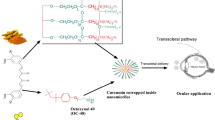Abstract
Age-related macular degeneration (AMD) and diabetic macular edema (DME) are common causes of blindness in people aged over 55 years. Current treatment involves frequent intravitreal administration of corticosteroids such as dexamethasone. The aim of this research was to formulate an electrically controlled delivery system for dexamethasone. Polypyrrole (PPy) was polymerized with dexamethasone sodium phosphate (Dex-P) through two approaches. Firstly, conventional films (CFs) of PPy were electropolymerized by applying a constant current density of 2 mA/cm2 for 4 min. Secondly, for the first time, we report drug-loaded ethanol-washed films (EWFs). EWFs were prepared in the same manner as CFs, except ethanol washing steps were introduced in the middle and at the end of PPy electropolymerization. The ethanol washing removed unbound PPy oligomers resulting in the formation of smooth surfaces with two distinct layers when viewed in cross-section. The EWFs showed superior electrochemical activity compared to CFs. Sustained release was observed from both CFs and EWFs with bursts of release triggered by electrical stimulation. The EWFs were initially more responsive to the electrical trigger, offering future opportunities to fine tune release. The cytotoxicity of aqueous extracts collected from both films was evaluated on human adult retinal pigment epithelium (ARPE-19) cells using a 3-(4,5-dimethylthiazol-2-yl)-2,5-diphenyltetrazolium bromide (MTT) assay with negligible toxicity observed. The results suggest PPy-Dex-P films are highly suitable for the development of electro-responsive implants for the treatment of AMD and DME.






Similar content being viewed by others
References
Coleman HR, Chan C-C, Ferris III FL, Chew EY. Age-related macular degeneration. Lancet. 2008;372(9652):1835–45. doi:10.1016/S0140-6736(08)61759-6.
Seyfoddin A, Chan A, Chen WT, Rupenthal ID, Waterhouse GIN, Svirskis D. Electro-responsive macroporous polypyrrole scaffolds for triggered dexamethasone delivery. Eur J Pharm Biopharm. 2015;94:419–26. doi:10.1016/j.ejpb.2015.06.018.
Herrero-Vanrell R, Cardillo JA, Kuppermann BD. Clinical applications of the sustained-release dexamethasone implant for treatment of macular edema. Clin Ophthalmol (Auckland, NZ). 2011;5:139–46. doi:10.2147/OPTH.S15783.
Wang Y, Wang VM, Chan CC. The role of anti-inflammatory agents in age-related macular degeneration (AMD) treatment. Eye. 2011;25(2):127–39. doi:10.1038/eye.2010.196.
Yoshida M, Lahann J. Smart nanomaterials. ACS Nano. 2008;2(6):1101–7. doi:10.1021/nn800332g.
Sharma M, Waterhouse GIN, Loader SWC, Garg S, Svirskis D. High surface area polypyrrole scaffolds for tunable drug delivery. Int J Pharm. 2013;443(1–2):163–8. doi:10.1016/j.ijpharm.2013.01.006.
Svirskis D, Travas-Sejdic J, Rodgers A, Garg S. Electrochemically controlled drug delivery based on intrinsically conducting polymers. J Control Release. 2010;146(1):6–15.
Sadki S, Schottland P, Brodie N, Sabouraud G. The mechanisms of pyrrole electropolymerization. Chem Soc Rev. 2000;29(5):283–93. doi:10.1039/A807124A.
Dall’Acqua L, Tonin C, Varesano A, Canetti M, Porzio W, Catellani M. Vapour phase polymerisation of pyrrole on cellulose-based textile substrates. Synth Met. 2006;156(5–6):379–86. doi:10.1016/j.synthmet.2005.12.021.
Leprince L, Dogimont A, Magnin D, Demoustier-Champagne S. Dexamethasone electrically controlled release from polypyrrole-coated nanostructured electrodes. J Mater Sci Mater Med. 2010;21(3):925–30. doi:10.1007/s10856-010-4008-6.
Zheng W, Razal JM, Spinks GM, Truong V-T, Whitten PG, Wallace GG. The role of unbound oligomers in the nucleation and growth of electrodeposited polypyrrole and method for preparing high strength, high conductivity films. Langmuir. 2012;28(29):10891–7. doi:10.1021/la301701g.
Sangian D, Zheng W, Spinks GM. Optimization of the sequential polymerization synthesis method for polypyrrole films. Synth Met. 2014;189:53–6.
Vaitkuviene A, Kaseta V, Voronovic J, Ramanauskaite G, Biziuleviciene G, Ramanaviciene A. Evaluation of cytotoxicity of polypyrrole nanoparticles synthesized by oxidative polymerization. J Hazard Mater. 2013;250–251:167–74. doi:10.1016/j.jhazmat.2013.01.038.
Saarinen-Savolainen P, Järvinen T, Araki-Sasaki K, Watanabe H, Urtti A. Evaluation of cytotoxicity of various ophthalmic drugs, eye drop excipients and cyclodextrins in an immortalized human corneal epithelial cell line. Pharm Res. 1998;15(8):1275–80. doi:10.1023/A:1011956327987.
Thompson BC, Moulton SE, Ding J, Richardson R, Cameron A, O’Leary S, et al. Optimising the incorporation and release of a neurotrophic factor using conducting polypyrrole. J Control Release. 2006;116(3):285–94. doi:10.1016/j.jconrel.2006.09.004.
Yoon CO, Sung HK, Kim JH, Barsoukov E, Kim JH, Lee H. The effect of low-temperature conditions on the electrochemical polymerization of polypyrrole films with high density, high electrical conductivity and high stability. Synth Met. 1999;99(3):201–12. doi:10.1016/S0379-6779(98)01494-5.
Smith TJ, Pearson PA, Blandford DL, Brown JD, Gions KA, Hollins JL, et al. Intravitreal sustained-release ganciclovir. JAMA Opthalmol. 1992;110(2):255–8.
Driot JY, Novack GD, Rittenhouse KD, Milazzo C, Pearson PA. Ocular pharmacokinetics of fluocinolone acetonide after Retisert intravitreal implantation in rabbits over a 1-year period. J Ocul Pharmacol Ther. 2004;20(3):269–75.
Guest GH, McFarlane WD. A study of the colorimetric determination of pyrrole with isatin and the application of the method to biological materials. Can J Res. 1939;17b(4):133–8. doi:10.1139/cjr39b-020.
Fromm F. Die stufenphotometrische Bestimmung kleiner Pyrrolmengen. Mikrochemie. 1935;17(1):141–54. doi:10.1007/BF02740127.
Petersen A, Carlsson T, Karlsson J-O, Jonhede S, Zetterberg M. Effects of dexamethasone on human lens epithelial cells in culture. Mol Vis. 2008;14:1344–52.
Sharma M, Svirskis D, Garg S. Advances in drug-delivery systems based on intrinsically conducting polymers. Smart materials for drug delivery: volume 1. R Soc Chem. 2013. p. 283–303.
Riss T. Is your MTT assay really the best choice? Promega Corporation. 2014. http://www.promega.com/~/pdf/resources/pubhub/is-your-mtt-assay-really-the-best-choice/. Accessed 17 Aug 2015.
Du J, McEwen B, Manji HK. Glucocorticoid receptors modulate mitochondrial function: a novel mechanism for neuroprotection. Commun Integr Biol. 2009;2(4):350–2.
Park Y-S, Ohta T, Takeoka S, Yamamoto K, Tsuchida E. Sintered-tantalum electrode modified with polypyrrole by electropolymerization. Bull Chem Soc Jpn. 1993;66(8):2449–51. doi:10.1246/bcsj.66.2449.
Ge D, Tian X, Qi R, Huang S, Mu J, Hong S, et al. A polypyrrole-based microchip for controlled drug release. Electrochim Acta. 2009;55(1):271–5. doi:10.1016/j.electacta.2009.08.049.
Acknowledgments
We would like to thank the University of Auckland’s Faculty of Medical and Health Science Research Development Fund, the Health Research Council of New Zealand, and the MacDiarmid Institute for Advanced Materials and Nanotechnology for funding this research.
Author information
Authors and Affiliations
Corresponding author
Rights and permissions
About this article
Cite this article
Ramtin, A., Seyfoddin, A., Coutinho, F.P. et al. Cytotoxicity considerations and electrically tunable release of dexamethasone from polypyrrole for the treatment of back-of-the-eye conditions. Drug Deliv. and Transl. Res. 6, 793–799 (2016). https://doi.org/10.1007/s13346-016-0284-0
Published:
Issue Date:
DOI: https://doi.org/10.1007/s13346-016-0284-0




